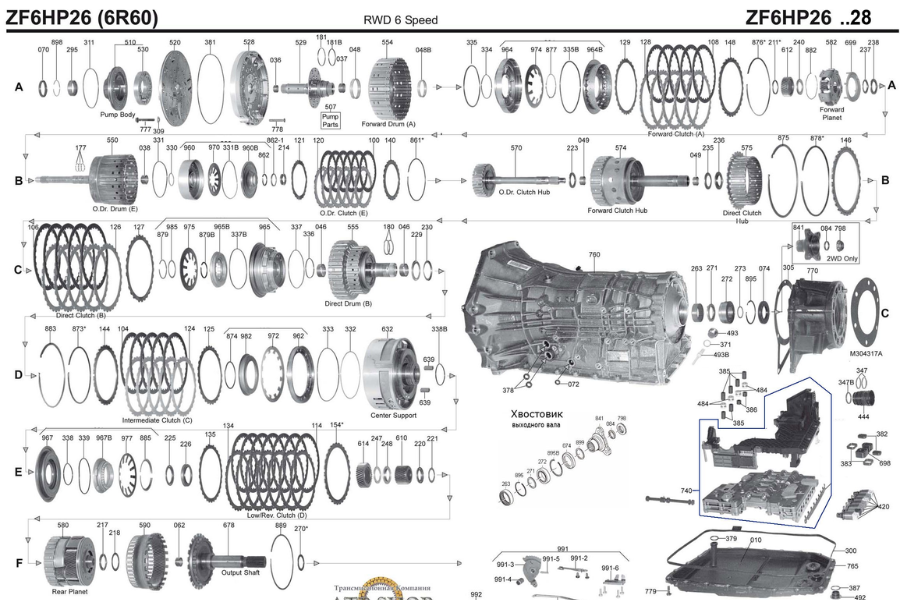Understanding the ZF 6HP19 and ZF 6HP21 Generation 2 Solenoid Diagram PDF
Introduction: John’s Transmission Troubles
John was ecstatic when he first got behind the wheel of his used BMW, enjoying the smooth performance that the car offered. But after a few months, he noticed something off—the transmission began to act up. Rather than immediately seeking professional help, John decided to take matters into his own hands and dive into online research. He spent countless hours browsing through forums and technical guides before stumbling upon a critical resource: the ZF 6HP19 and ZF 6HP21 Generation 2 Solenoid Diagram PDF. This detailed diagram would be the key to diagnosing and fixing his car’s transmission issues.
Why the Solenoid Diagram Matters
The ZF 6HP19 and 6HP21 Generation 2 solenoid diagrams are indispensable for anyone facing transmission problems in vehicles equipped with these transmissions. Commonly found in various car models, these ZF transmissions rely heavily on solenoids for their operation, making it essential to understand their layout and functions for effective troubleshooting and repair. The diagram provides a comprehensive view of the transmission’s internal components, specifically detailing the position and purpose of each solenoid. For John, this meant uncovering which parts were likely responsible for his car’s shifting problems.
Simplifying Troubleshooting with the Diagram
Armed with the ZF 6HP19 and 6HP21 solenoid diagram, John was able to approach his transmission issues methodically. The diagram mapped out which solenoids were responsible for specific functions, like gear shifts and hydraulic pressure regulation. This clear visualization allowed John to trace the source of his transmission woes to a particular solenoid, pinpointing the faulty component that was causing his BMW’s erratic shifting.
Breaking Down the Diagram: Key Components
The ZF 6HP19 and 6HP21 solenoid diagram outlines the following crucial components:
- Shift Solenoids: These control the gear changes within the transmission.
- Pressure Control Solenoids: These solenoids manage the hydraulic pressure levels that affect shifting and overall transmission performance.
- Torque Converter Clutch (TCC) Solenoid: This component handles the locking and unlocking of the torque converter, impacting the transmission’s efficiency.
Each solenoid plays a critical role in maintaining smooth transmission operation. Through the diagram, John identified that a malfunction in the pressure control solenoid was the root cause of the inconsistent pressure levels affecting his car’s shifting.
A Step-by-Step Repair Guide
Using the ZF 6HP19 and 6HP21 Generation 2 Solenoid Diagram PDF, John followed a detailed step-by-step process to replace the faulty solenoid. Here’s a simplified version of his repair journey:
- Safety Precautions: John made sure the car was on a flat surface, engaged the parking brake, and disconnected the battery for safety.
- Drain the Transmission Fluid: He removed the transmission pan and drained the fluid into a suitable container.
- Remove the Transmission Valve Body: To access the solenoids, John carefully detached the valve body from the transmission.
- Identify the Faulty Solenoid: Using the solenoid diagram, he located the problematic pressure control solenoid.
- Replace the Solenoid: John removed the defective solenoid and installed a new one, ensuring all connections were properly secured.
- Reassemble and Refill: After reattaching the valve body and replacing the transmission pan, he refilled the transmission with the recommended fluid.
- Test Drive: Finally, he reconnected the battery and took the car for a test drive to verify that the transmission was functioning as expected.
Facts
- ZF 6HP19 and 6HP21 Transmissions: These are common transmission models found in various vehicles, including BMWs. They rely heavily on solenoids for their operation.
- Solenoid Diagrams: The ZF 6HP19 and 6HP21 Generation 2 solenoid diagrams provide a detailed view of the internal components of these transmissions, including the position and function of each solenoid.
- Types of Solenoids:
- Shift Solenoids: Control gear changes within the transmission.
- Pressure Control Solenoids: Manage hydraulic pressure levels, affecting shifting and overall transmission performance.
- Torque Converter Clutch (TCC) Solenoid: Handles the locking and unlocking of the torque converter, impacting the transmission’s efficiency.
- Troubleshooting Process: The diagram helps identify faulty solenoids, which can be critical for diagnosing issues like erratic shifting.
- Repair Steps:
- Safety precautions include parking on a flat surface, engaging the parking brake, and disconnecting the battery.
- Drain the transmission fluid and remove the transmission pan.
- Detach the transmission valve body to access the solenoids.
- Identify and replace the faulty solenoid using the diagram as a guide.
- Reassemble the components, refill the transmission with the recommended fluid, and test drive the vehicle.
Summary
The article narrates John’s journey of diagnosing and fixing his BMW’s transmission issues using the ZF 6HP19 and ZF 6HP21 Generation 2 Solenoid Diagram PDF. These solenoid diagrams are essential for understanding the transmission’s internal components, helping pinpoint specific solenoids responsible for issues like erratic shifting. By leveraging the diagram, John identified a malfunction in the pressure control solenoid, which was causing his car’s transmission problems. He followed a detailed repair process that included safety measures, draining the transmission fluid, removing the valve body, replacing the faulty solenoid, and reassembling the components. The solenoid diagram proved invaluable in guiding John through a successful repair, restoring his car’s smooth performance.
FAQs
Q1: What are the ZF 6HP19 and 6HP21 transmissions?
- A: The ZF 6HP19 and 6HP21 are automatic transmission models commonly used in various vehicles, including BMWs. They rely on solenoids to control shifting and pressure regulation.
Q2: Why is the ZF 6HP19 and 6HP21 solenoid diagram important?
- A: The solenoid diagram provides a detailed view of the internal components of the transmission, specifically outlining the positions and functions of each solenoid. It is crucial for diagnosing and fixing transmission issues.
Q3: What are the key components shown in the solenoid diagram?
- A: The key components include shift solenoids, pressure control solenoids, and the torque converter clutch (TCC) solenoid, each playing a critical role in the transmission’s operation.
Q4: How can the solenoid diagram simplify troubleshooting?
- A: The diagram helps identify which solenoids are responsible for specific functions, allowing users to trace the source of transmission problems, such as erratic shifting, to a particular solenoid.
Q5: What are the steps to replace a faulty solenoid using the diagram?
- A: The steps include taking safety precautions, draining the transmission fluid, removing the valve body, identifying the faulty solenoid, replacing it, reassembling the transmission, and conducting a test drive.
Q6: Can the solenoid diagram be used by non-professionals?
- A: Yes, with careful study and understanding, non-professionals like John can use the solenoid diagram to diagnose and repair transmission issues, provided they follow safety procedures and have basic mechanical knowledge.






